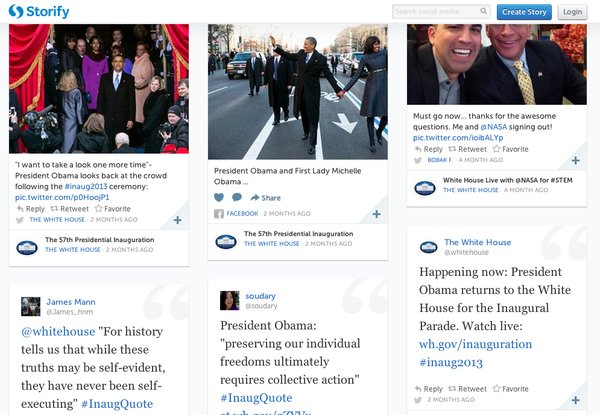Brands
Five Reasons Why Storify Points to the Future of Content
Ten years ago, it would have been hard to imagine Storify, an online curation app that gives publishers the tools to build content using social media.
Tweets, YouTube video, Facebook updates, blog posts — all can be scoped out and scooped up by Storify.

Storify is one of digital content’s invisible success stories. It launched in 2010 and has been open to the public since April 2011. Adopted by ABC News, Canada’s CBC network and the UK’s Guardian newspaper as a storytelling tool, it’s the slickest of an emerging class of content making applications.
A growing number of brands, such as General Electric and HP, are using the platform to curate and publish.
Everyone’s a Reporter Now
Content makers, the truth is, everyone can do what you do now. And the thing about everyone — they’re everywhere.
The crowd is ubiquitous. It’s on every beat, at every trade show, protest, opening night and convention. It has HD video vision and can broadcast instantaneously to 200 million active users, in 140 character chunks. Smartphones and social media are digital gathering and distribution platforms that have changed everything.

But none of these audio snippets or status updates or vintage filtered images can ever tell the entire story. It still takes a journalist or author to do that.
Storify enables us to dip into the chaos and craft narrative from multiple, secondary sources, to make sense of the social.
It also enables participants in the news get their story out, direct.
“The White House has been really active on Storify,” says head of community support for Storify, Skyler Rogers. “We have an ’embed as slideshow’ option for stories which was used on the White House website the day of President Obama’s inauguration.”
Attribution is Key
People still own the rights to everything they make. It’s a fact that is often muddied and lost as digital media plunders the plethora of secondary sources online.
Storify has that covered. Every sound bite, video clip or blog snippet is attributed to the creator in Storify, automatically. Click the link, you’re back to the source. It transforms online content into the hypertextual, interconnected mega-media pioneers like Ted Nelson and Douglas Englebart dreamed of.

Web content is multidimensional
Online content doesn’t have to be just text. In fact, it’s better if it isn’t. Usability guru Jacob Neilsen tells us that people don’t read content online. They scan it instead, picking up blips of information.
It’s why this piece is broken up into paragraphs that are no longer than two or three sentences. It’s why there are headings every hundred words or so.

We package content up into chunks. We can mix things up with a video clip here and an image there. The experience can be multimedia as well as hypertextual. Storify makes that easy.
Integrate, everywhere
Storify’s developers were savvy in realizing that the content you create with the platform looks good anywhere. But, instead of making content exportable, they made it embeddable.
When the Washington Post or Buzzfeed use Storify to gather tweets or aggregate YouTube videos of the Harlem Shake, Storify drives it. That’s their logo you see, embedded in an iFrame, right on the page. The site comes to you.

Emerging curation tools
There are hundreds of curation tools. Some are more narrowly targeted than Storify, others impose dimensional structure. Dipity makes curation possible along timelines. Scoop.it enables you to collate long-form content.
It’s early days for the practice of curation. Though we’ve highlighted some of the bigger names using the service, many of its best and most innovative users are individuals. Students and bloggers aren’t so deeply entrenched in the environmental rules of organizations.
“I’m seeing Storify mentioned amongst journalism students and professors more and more every day,” says Skyler, “Within hours of Hugo Chavez’s death recently, a student named Courtney Pence had curated details and reactions from tons of sources online, and it made for some of the best ‘in the moment’ coverage I saw that afternoon, scooping some of our bigger accounts and earning a featured spot on our homepage.”

Get better at your job right now.
Read our monthly newsletter to master content marketing. It’s made for marketers, creators, and everyone in between.




